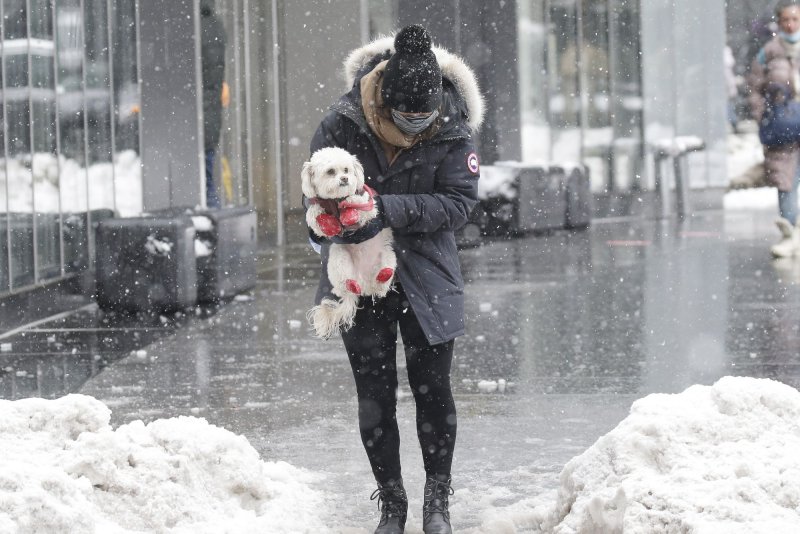1 of 5 | A woman carries a small dog after a major snow storm in New York City on February 2. A major nor'easter had dumped more than 16 inches of snow in Manhattan during that storm. File Photo by John Angelillo/UPI |
License Photo
June 7 -- With a touch of wet snow that fell over what turned out to be a mostly dismal Memorial Day weekend across the Northeast, the final flakes of the season have likely fallen.
As summer approaches and heat waves loom for the Northeast, let's cool off with a look back at the 2020-2021 winter season and the places that piled up the highest snowfall totals throughout the region.
For many residents across the Northeast and mid-Atlantic, the 2020-21 winter season may have seemed very snowy compared to normal, but the official snowfall totals compiled by the National Weather Service tell a different story.
"It was snowy at times, but this winter was mostly a sleeper," said AccuWeather Northeast Forecasting Expert Dave Dombek, who added that while snowfall totals were near or just above normal, it can be deceptive looking at the season as a whole.
There were two active periods of weather in the East this winter, a "one-hit-wonder" in mid-December and rounds of snowfall in late January and early February.
"The distribution of snowfall throughout the season was not normal," said Dombek. "If those two time periods are removed, it was pretty quiet."
State College, Pa., is a perfect example of this, Dombek pointed out. The central Pennsylvania town reported 45.7 inches of snow from October to May, just barely topping the yearly normal of 45.6 inches.
Nearly one-third of the seasonal snowfall in State College came with the blockbuster storm in December, when 15 inches fell over just 24 hours on Dec. 16.
So which places were the big winners in terms of total snow accumulation across the eastern United States this year?
Caribou in Maine finished the season with the highest snowfall total in the region with a staggering 107.9 inches. However, the total fell just short of normal for the far northern Maine town. On average, Caribou picks up 108.6 inches throughout the season.
The second-highest snowfall total for the Northeast was recorded in Binghamton, N.Y., where 104.7 inches of snow fell. Normal snowfall there is around 83.4 inches.
"Even though Binghamton had an above-normal snowfall season with over 100 inches of snow, including a historic 40-inch snowstorm in mid-December, the snow season ended quickly and with a whimper in March," said AccuWeather Senior Meteorologist Dan Pydynowski.
"Binghamton had only 2.5 inches for the whole month of March. The location typically averages 15 inches for the month and quickly lost its entire snow cover by the second week of the month," said Pydynowski, adding that the city actually picked up more snow in April with 4.6 inches.
Other cities in the Northeast that had above-normal snowfall include New York City with 38.6 inches, Pittsburgh with 57.7 inches, Philadelphia with 23.9 inches and the Scranton/Wilkes Barre area in Pennsylvania. Normal seasonal totals for these cities are 25.8 inches, 41.4 inches, 22.4 inches and 46.5 inches, respectively.
But many residents across parts of the Northeast and mid-Atlantic may feel like this season was much snowier than previous winters.
"After a snow drought the previous winter east of mountains, a near-normal and in some places above-normal winter snowfall seemed much snowier this past winter," said AccuWeather Senior Meteorologist Paul Walker.
While New York City and Philadelphia recorded snowfall totals that were greater than normal, Washington, D.C., Baltimore and Richmond, Virginia, all fell short of normal snow accumulation totals.
However, no matter where the snowfall totals fell compared to normal, these cities along the Interstate-95 corridor received more snowfall this past winter than the winter of 2019-2020.
Washington, D.C., reported 12 inches of snow this winter compared to just 2.9 inches during 2019-2020. The nation's capital typically picks up 22 inches of snow in a season.
In Baltimore and Richmond, totals reached 10.9 and 7 inches. Each city typically reports 20.1 and 10.3 inches of snow during the winter.
Portions of the Great Lakes are known for staggering snowfall totals during the winter months as cold air surging over the warmer lakes creates bands of heavy lake-effect snow. This year was a different story.
Buffalo and Syracuse, N.Y., and Erie, Pa., typically report around 94.7, 123.8 and 100.9 inches of snowfall a year, respectively. This year, Buffalo measured just 77.2 inches, Syracuse 73.3 inches and Erie 64.3 inches, according to NWS data. This is at least the second year in a row for below-normal snowfall for these Great Lakes cities.
"Snowfall was below normal around the Great Lakes," said Dombek, adding that the pattern throughout the season was not conducive for lake-effect snow events.
The front that oscillated back and forth over the Northeast and mid-Atlantic throughout much of the season prevented the persistent northwest winds and intrusions of Arctic air that allow lake-effect snow bands to set up, explained Dombek.
This pattern also prevented the formation of ice on the lakes until later in the winter.
















